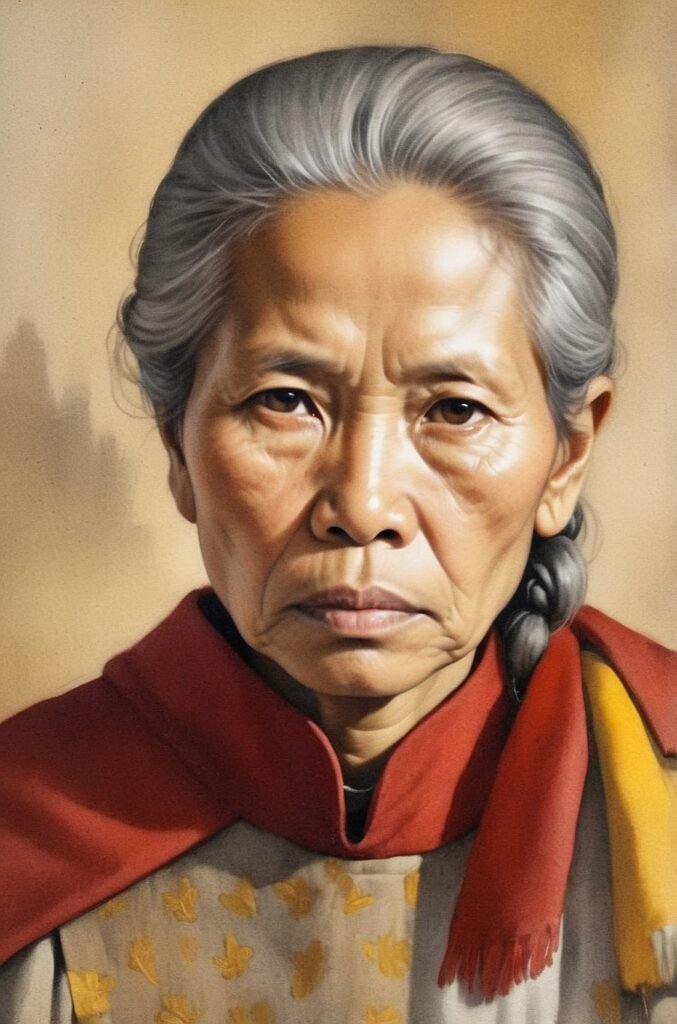Teresa Magbanua, often referred to as the “Visayan Joan of Arc,” was a Filipino revolutionary leader and military commander who played a significant role in the Philippine Revolution against Spanish colonial rule and the subsequent Philippine-American War. Her remarkable courage, strategic acumen, and unwavering dedication to the cause of Filipino independence have earned her a place among the most revered figures in Philippine history. This blog post delves into the life, accomplishments, and enduring legacy of Teresa Magbanua, exploring her contributions to the Filipino struggle for freedom and her impact on the nation’s cultural and historical narrative.
Early Life and Education
Birth and Family Background
Teresa Magbanua was born on October 13, 1868, in Pototan, Iloilo, Philippines. She was the daughter of Don Juan Magbanua and Doña Alejandra Ferraris, both of whom belonged to prominent families in the region. Growing up in a privileged household, Teresa was exposed to a world of education and opportunity that was rare for women of her time.
Educational Pursuits
Teresa’s early education began at home, where she was tutored by her uncle, Father Fulgencion Saenz. Recognizing her intellectual potential, her family decided to send her to pursue higher education in Manila. This decision was groundbreaking for the era, as it was uncommon for women to receive advanced schooling.
Teresa’s educational journey included:
- Attending Colegio de San Jose in Jaro, Iloilo
- Studying at Colegio de Santa Rosa in Manila
- Enrolling in the University of Santo Tomas Teacher’s College
Her dedication to learning culminated in her earning a teaching degree, a remarkable achievement for a woman in the late 19th century Philippines. This educational background would later prove invaluable in her revolutionary activities, providing her with the knowledge and skills to become an effective leader and strategist.
The Road to Revolution
Political Climate in the Philippines
To understand Teresa Magbanua’s journey into revolutionary activities, it is essential to examine the political climate of the Philippines in the late 19th century. The country was under Spanish colonial rule, which had lasted for over three centuries. This period was marked by:
- Oppressive governance and economic exploitation
- Social inequality and racial discrimination
- Limited opportunities for native Filipinos
- Growing discontent among the populace
These factors contributed to the rise of nationalist sentiments and the formation of revolutionary movements across the archipelago.
Involvement in the Katipunan
The Katipunan, a secret revolutionary society founded by Andres Bonifacio in 1892, played a crucial role in organizing the Filipino resistance against Spanish rule. Teresa Magbanua’s involvement with the Katipunan began through her family connections. Her brothers, Pascual and Elias, were active members of the organization in the Visayas region.
Teresa’s initial participation in revolutionary activities included:
- Providing logistical support to Katipunan members
- Assisting in the distribution of propaganda materials
- Gathering intelligence on Spanish military movements
Her dedication to the cause and her natural leadership abilities soon led her to take on a more active role in the revolution.
Military Career and Achievements
Rise to Military Leadership
Teresa Magbanua’s transition from a supportive role to a military leader was driven by her exceptional abilities and the urgent need for capable commanders in the revolutionary forces. Her ascent to military leadership was marked by several key factors:
- Strategic acumen demonstrated in early engagements
- Ability to rally and inspire troops
- Knowledge of the local terrain and community networks
- Unwavering commitment to the revolutionary cause
These qualities set her apart and earned her the respect of both her fellow revolutionaries and her opponents.
Notable Battles and Victories
Throughout her military career, Teresa Magbanua participated in numerous battles against both Spanish and American forces. Some of her most notable engagements include:
| Battle | Year | Outcome |
|---|---|---|
| Battle of Barrio Yoting | 1898 | Victory against Spanish forces |
| Battle of Sapong Hills | 1898 | Successful defense against Spanish attack |
| Siege of Iloilo | 1899 | Resistance against American occupation |
Her tactical prowess and bravery in these battles earned her the moniker “Visayan Joan of Arc,” drawing parallels to the French heroine who led armies in the 15th century.
Leadership Style and Military Tactics
Teresa Magbanua’s leadership style was characterized by:
- Leading from the front, often participating in direct combat
- Employing guerrilla warfare tactics to offset the enemy’s superior firepower
- Utilizing her knowledge of local geography to gain strategic advantages
- Maintaining high morale among her troops through personal example and inspirational speeches
Her ability to adapt to changing battlefield conditions and make quick, effective decisions contributed significantly to her success as a military commander.
Role in the Philippine-American War
Transition from Spanish to American Occupation
Following the defeat of Spain in the Spanish-American War, the Philippines found itself under American colonial rule. This transition presented new challenges for the Filipino revolutionaries, including Teresa Magbanua. The period was marked by:
- Initial hopes for independence, quickly dashed by American intentions to colonize
- Shift in revolutionary focus from Spanish to American opponents
- Need to adapt tactics and strategies to face a new, more technologically advanced enemy
Continued Resistance Against American Forces
Teresa Magbanua’s role in the Philippine-American War was characterized by her unwavering commitment to Filipino independence. Her activities during this period included:
- Organizing and leading guerrilla units in the Visayas region
- Coordinating with other revolutionary leaders to maintain a united front
- Engaging in both military and propaganda efforts to resist American occupation
Her persistence in the face of overwhelming odds served as an inspiration to many Filipinos who continued to fight for their nation’s freedom.
Legacy and Impact
Influence on Women’s Participation in the Revolution
Teresa Magbanua’s remarkable career as a military leader had a profound impact on the perception of women’s roles in Philippine society, particularly in the context of the revolution. Her achievements:
- Challenged traditional gender norms and expectations
- Inspired other women to take active roles in the independence movement
- Demonstrated that women could be effective leaders in both military and civilian spheres
This legacy contributed to the broader movement for women’s rights and empowerment in the Philippines.
Recognition and Honors
While Teresa Magbanua’s contributions were not immediately recognized in the aftermath of the wars, her legacy has grown over time. Some of the honors and recognitions she has received include:
- Inclusion in Philippine history textbooks as a notable revolutionary figure
- Commemorative stamps issued in her honor
- Streets and schools named after her in various parts of the Philippines
- Inclusion in national celebrations of heroes and historical figures
These recognitions serve to cement her place in the pantheon of Filipino national heroes.
Impact on Philippine Historical Narrative
Teresa Magbanua’s story has become an integral part of the Philippine historical narrative, contributing to:
- A more comprehensive understanding of the roles played by regional leaders in the revolution
- Greater recognition of women’s contributions to nation-building
- The development of a more inclusive and diverse national identity
Her life and achievements continue to be studied by historians and celebrated by Filipinos as an example of patriotism and courage.
Personal Life and Later Years
Family and Relationships
Despite her prominent role in the revolution, Teresa Magbanua maintained strong family ties throughout her life. Key aspects of her personal life include:
- Marriage to Alejandro Balderas, a wealthy landowner from Sara, Iloilo
- Support from her husband for her revolutionary activities
- Continued close relationships with her siblings, many of whom were also involved in the independence movement
These personal connections provided emotional support and practical assistance during her years of revolutionary struggle.
Post-War Activities
Following the end of the Philippine-American War, Teresa Magbanua’s life took a different direction:
- Returned to civilian life and focused on managing family properties
- Continued to advocate for veterans’ rights and recognition
- Engaged in community service and education initiatives
- Maintained connections with fellow veterans and revolutionary leaders
Her transition to civilian life demonstrated her versatility and ongoing commitment to serving her community.
Final Years and Death
Teresa Magbanua’s later years were marked by:
- Relocation to Mindanao to be closer to family members
- Continued interest in national affairs and politics
- Reflection on her experiences during the revolutionary period
She passed away on August 14, 1947, in Pagadian, Zamboanga del Sur, leaving behind a legacy that would continue to inspire generations of Filipinos.
Historical Context and Significance
The Philippine Revolution in Global Perspective
To fully appreciate Teresa Magbanua’s contributions, it is important to consider the Philippine Revolution within the broader context of global anti-colonial movements. This period was characterized by:
- Growing resistance to European colonial powers across Asia and Africa
- The emergence of nationalist movements and ideologies
- The declining influence of traditional imperial powers
- The rise of the United States as a new global power
The Philippine struggle for independence, in which Teresa Magbanua played a crucial role, was part of this larger historical trend toward decolonization and national self-determination.
Comparative Analysis with Other Revolutionary Figures
Teresa Magbanua’s achievements can be better understood when compared to other revolutionary figures of her time:
| Revolutionary Figure | Country | Notable Contributions |
|---|---|---|
| Teresa Magbanua | Philippines | Military leadership in Visayas region |
| Emilio Aguinaldo | Philippines | First President of the Philippine Republic |
| José Rizal | Philippines | Intellectual leader and national hero |
| Sun Yat-sen | China | Leader of the Chinese Revolution |
| Mahatma Gandhi | India | Pioneer of non-violent resistance |
While each of these figures operated in different contexts, they all contributed significantly to their nations’ struggles for independence and self-determination.
Challenges in Historical Research
Limited Primary Sources
One of the challenges in studying Teresa Magbanua’s life and achievements is the limited availability of primary sources. This scarcity is due to several factors:
- Destruction of records during wartime
- Limited documentation of women’s roles in historical events
- Focus on more prominent national figures in early historical accounts
- Oral tradition as the primary means of preserving local histories
These limitations have required historians to piece together Teresa Magbanua’s story from a variety of sources, including oral histories, military records, and personal accounts from her contemporaries.
Evolving Historical Perspectives
The interpretation of Teresa Magbanua’s role in Philippine history has evolved over time, reflecting changing societal attitudes and historical methodologies. This evolution has been characterized by:
- Increased focus on regional and local histories
- Growing recognition of women’s contributions to historical events
- Reevaluation of the complexities of colonial and post-colonial narratives
- Integration of diverse perspectives in historical research and education
These changing perspectives have contributed to a more nuanced and comprehensive understanding of Teresa Magbanua’s place in Philippine history.
Conclusion
Teresa Magbanua’s life and achievements stand as a testament to the courage, determination, and patriotism of the Filipino people during a critical period in their nation’s history. Her role as a military leader in the Visayas region during both the Philippine Revolution and the Philippine-American War challenged gender norms and inspired generations of Filipinos to fight for their rights and freedoms.
As the “Visayan Joan of Arc,” Teresa Magbanua embodied the spirit of resistance against colonial oppression and the struggle for national self-determination. Her legacy continues to resonate in the Philippines today, serving as a powerful reminder of the contributions of regional leaders and women to the country’s fight for independence.
The story of Teresa Magbanua also highlights the complexities of Philippine history, the challenges of historical research, and the importance of preserving and studying diverse perspectives on national events. As scholars continue to uncover and analyze new information about this remarkable woman and her era, our understanding of Philippine history and the role of individuals in shaping it will undoubtedly be enriched.
Teresa Magbanua’s life serves as an inspiration not only to Filipinos but to people around the world who strive for justice, equality, and national sovereignty. Her courage in the face of overwhelming odds, her leadership in times of crisis, and her unwavering commitment to her principles make her a true hero whose story deserves to be told and remembered.
Disclaimer: While every effort has been made to ensure the accuracy of the information presented in this blog post, historical research is an ongoing process, and new information may come to light that could alter our understanding of events. Featured Photo is sourced from a Government Website and are in public domain. Readers are encouraged to consult primary sources and academic works for the most up-to-date and comprehensive information on Teresa Magbanua and the historical periods discussed. If you notice any inaccuracies in this post, please report them so we can correct them promptly.




